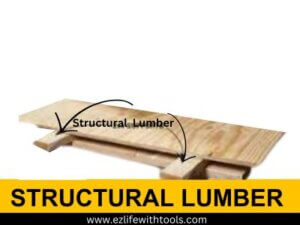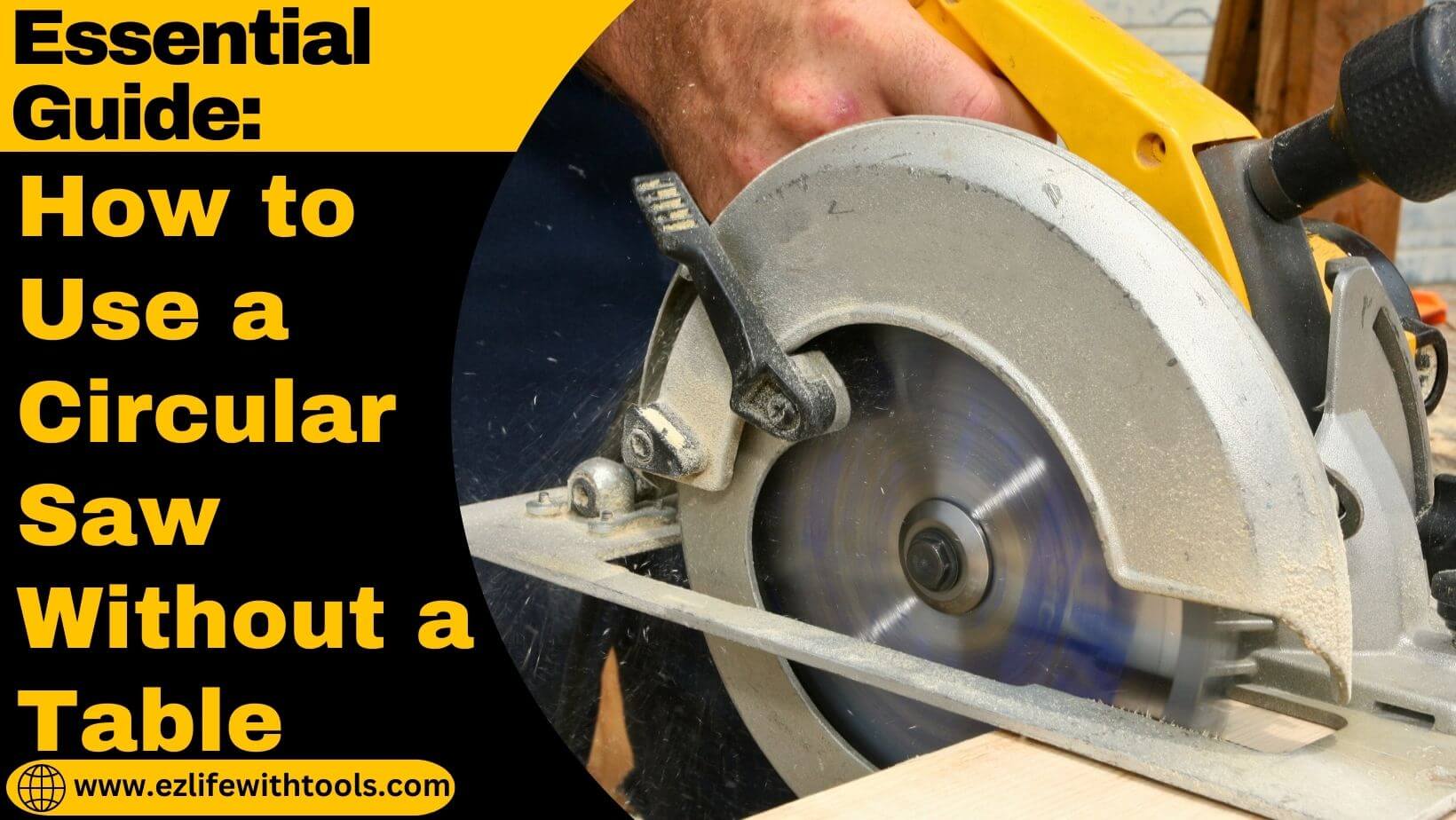Essential Guide: How to Use a Circular Saw Without a Table

A beginner always lacks instruments. Therefore, they think about how to use a circular saw without a table.
No doubt, without a table, using a circular saw is a little tricky but not impossible. Using the circular saw without a table only requires skill and the right approach.
So don’t worry.
In this article, I will guide you through the essential tools, methods, and safety tips for using the circular saw without a table.
So, keep with us to learn better.
Considerations Before Setting Up
When you use a circular saw without a table, you should remember these critical factors in your mind to get accurate results.
Let’s explain these critical factors.
Supporting the Material
Before starting the cutting operation, you should place proper support under the workpiece. Unstable and unsupported material can cause kickbacks, rough cuts, or accidents. So, always use sturdy platforms to keep the material in place during cutting.
Supporting the Cut Line
To create a clear and precise cut line, use a straight edge parallel to the adequately measured marked line to establish the exact path for the saw blade. This straight edge or guide will help you to maintain accuracy and prevent wandering cuts.
Space for the Sawblade
Circular saws have elongated blades that require plenty of space to move freely through the material. Make sure there are no obstructions around the cutting area, allowing the saw to move quickly without encountering obstacles.
Options for Using a Circular Saw Without a Table
If you do not have a dedicated saw table at your working site, several alternative setups can provide stable platforms for operating a circular saw effectively.
Using a Sheet of Foam Insulation
Foam insulation sheets can serve as an excellent temporary surface for cutting. Lay these foam sheets on a flat, stable area and place the workpiece you intend to cut on top.
The foam’s surface will help the saw blade to cut through without damaging the floor beneath and provide a clean-cutting environment.
Utilizing Structural Lumber
Structural lumber consists of sturdy wooden pieces, 2×4, that can be arranged on the ground to create a temporary cutting platform. This setup will provide a stable base for precise cuts.
However, ensure that all the structural lumber is securely placed and leveled to prevent any shifting or disturbance during cutting.
Setting Up Sawhorses
Sawhorses are a versatile and proper solution to support the material during cutting. Place two sawhorses at a suitable distance and place a sturdy board or sheet across them to provide a stable surface for cutting.
Sawhorses should be leveled and adequately secured to prevent wobbling or shifting while cutting.
How to Use a Circular Saw without a Table Using Different Methods
Achieving precise and straight cuts without a table requires specific methods and techniques.
Here, we’ll explain three primary methods that facilitate straight cuts without the need for a dedicated table.
- Using Insulation Sheet
- Using Structural Lumber
- Using Sawhorses
Using Insulation Sheet (Method 1)
- First, lay down a large foam insulation sheet on a flat surface, ensuring it’s stable and level.

How to Use a Circular Saw Without a Table - Place the material you want to cut on top of the insulation sheet. Ensure it’s positioned securely and won’t shift during cutting.
- Use a straight edge or a suitable guide to mark the precise cut line on the material’s surface.
- When operating the saw, follow the safety guidelines and use safety gear, like gloves and goggles.
- Start the circular saw and carefully guide it along the marked cut line.
- Maintain consistent pressure and a steady hand.
- Continue the process till you reach the other end of the cutting sheet.
Using Structural Lumber (Method 2)
- Choose a flat and level surface in your workspace to set up the structural lumber.
- Clear any debris or obstacles that may interfere with the cutting process.
- Place two pieces of structural lumber parallel to each other on the work surface.
- Ensure they are evenly spaced apart and perpendicular to the direction of the intended cut.

How to Use a Circular Saw Without a Table - Secure the structural lumber to the work surface to prevent any movement during cutting. Ensure these are stable and firmly positioned.
- Lay the workpiece you intend to cut on top of the arranged structural lumber.
- Align the workpiece with the intended cut line and ensure it is adequately supported along its length.
- Use a measuring tape, straight edge, or suitable guide to mark the precise cut line on the material’s surface.
- Again, check the markings for accuracy before cutting.
- Ensure the circular saw is set up properly, with the blade aligned with the marked cut line and the depth adjusted to cut through the material without excess blade exposure.
- Please turn on the circular saw and carefully guide it along the marked cut line.
- Maintain consistent pressure and a steady hand to achieve a clean and accurate cut.
- After completing the cut, inspect the material to ensure it meets the desired specifications. Check for accuracy, smoothness, and any potential issues.
Using Sawhorses (Method 3)
- Place two sturdy sawhorses at an appropriate distance apart and ensure they’re level and stable.

How to Use a Circular Saw Without a Table - Place a flat sheet on these sawhorses to provide a stable surface for material cutting.
- Lay the material to be cut on top of the sawhorses, securing it in place.
- Clearly mark the intended cut line on the material using a straight edge or a measuring tape.
- Please turn on the circular saw and carefully guide it along the marked cut line, maintaining a steady hand and even pressure.
- Continue this process till you reach the other end of the workpiece.
Note: These methods offer viable ways to achieve accurate and straight cuts using a circular saw without the need for a dedicated table. Choose the method that suits your workspace and materials to achieve optimal results.
Read also: How to Use Reciprocating Saw
Tips for Accuracy and Safety
When utilizing a circular saw without a table, implementing the following tips will enhance accuracy and reduce the risk of accidents.
- Measure Twice, Cut Once: Double-check measurements and markings before making any cuts because a little mistake can waste our precious materials.
- Secure Materials Properly: Before starting cutting, always use clamps, sturdy supports, or appropriate fixtures to secure the material. It will prevent movement or shifting during cutting and ensure precise results.
- Maintain a Clear Work Area: Remove clutter, debris, and obstacles from the cutting path for smooth movement of the saw. It will prevent accidents caused by obstructions.
- Follow the Cut Line Carefully: Apply consistent pressure to guide the circular saw precisely along the marked cut line to achieve straight and accurate cuts.
- Use Proper Depth of Blade: It is necessary to adjust the depth of the circular saw blade according to the workpiece depth and requirement to ensure it extends just beyond the material being cut.
- Prioritize Personal Safety: Always wear appropriate safety gear, like safety goggles, gloves, and ear muffs, to be safe against potential injury or from flying debris and noise.
- Be Mindful of Kickbacks: Stay vigilant and be prepared to handle kickbacks, which occur when the saw binds or pinches during cutting. Ensure a firm grip on the saw and maintain proper control.
Comparison and Takeaways Between Different Methods
When considering the methods for using a circular saw without a table, comparing the advantages and limitations of each approach can help in determining the most suitable method for specific cutting tasks.
Comparison of Insulation Sheet (Method 1)
Advantages:
- Provides a portable and easily accessible cutting surface.
- Ideal for smaller projects and materials that can be easily maneuvered.
- Protects the floor or surface beneath the cutting area.
Limitations:
- It may not be suitable for larger or heavier materials due to limited support.
- Requires a flat and stable surface for effective use.
Comparison of Structural Lumber (Method 2)
Advantages:
- Structural lumber is more affordable than other types of wood, which makes it cost-effective for different projects.
- This type of wood is easily accessible in different sizes and dimensions.
- With proper safety precautions and technique, using a circular saw with structural wood can be relatively straightforward, even for beginners.
Limitations:
- Although circular saws offer versatility, it can be difficult to achieve precise and accurate cuts, especially for complex designs or detailed woodworking projects.
- A Circular saw is a very powerful tool that requires proper handling and safety precautions. Without proper technique and safety equipment, the risk of accidents increases, including kickbacks, cuts, and injuries.
- Circular saws have limitations regarding cut depth. Thicker wood or deeper cuts may require multiple passes, which can affect the accuracy of the cut.
Comparison of Sawhorses (Method 3)
Advantages:
- Offers sturdy support for larger and heavier materials.
- Provides a stable cutting platform for more substantial projects.
- Allows for increased versatility and adaptability in cutting various materials.
Limitations:
- It is less portable compared to the insulation sheet method.
- Requires additional space for setup and storage.
Conclusion
Mastering the use of a circular saw without a table requires a deep understanding of safety measures and precise handling techniques.
Fortunately, all the foundational steps, tips, and methods I have already explained above.
If you are reading these lines, it means you have understood all the guidelines and know very well how to use a circular saw without a table.
Now, with practice, patience, and adherence to safety protocols, you can become an expert.
Thank you for your best time.
Best wishes

